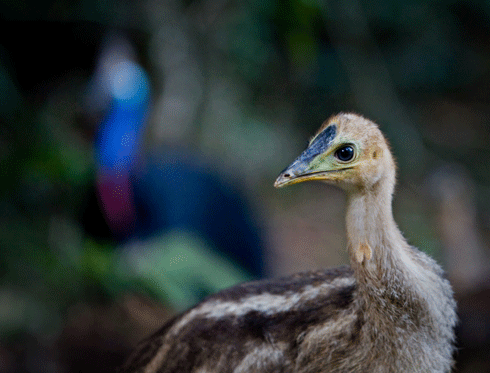
|
Published: 27 August 2012
Funding to help fight tramp ant threat to cassowaries
The Australian Government has allocated funds to combat the appearance of yellow crazy ants and another ‘tramp’ ant species inside Queensland’s protected Wet Tropics World Heritage Area.

|
|
A cassowary chick: yellow crazy ants pose a particular threat to chicks, but also threaten adult birds and other native species in the Wet Tropics. Credit:
Australian Rainforest Foundation
|
The yellow crazy ant outbreak, which has occurred at Little Mulgrave National Park near Edmonton, south of Cairns, poses a serious threat to cassowaries and other native species.
Yellow crazy ants, Anoplolepis gracilipes, are regarded as being among the world’s worst most dangerous invasive species, attacking, blinding, and killing vertebrates and invertebrates, and contributing to the decline or extinction of native species in areas they’ve invaded.
The ants form super colonies with multiple queens, reaching densities of up to 20 million ants per hectare and spreading up to 1 km per year.
Ground-nesting species, like cassowaries, are particularly vulnerable; there are fears the ants could blind and kill cassowary chicks.
Yellow crazy ants also farm sap-sucking insects, like scale and aphids, protecting them in exchange for the sweet sticky honeydew they produce. This can lead to mould infections in plants and reduced growth and flowering. In severe cases, this could lead to dieback, depleting cassowary food sources.
The Wet Tropics Management Authority (WTMA) recently announced it had secured funding to detect and control the two ant species through the Commonwealth’s Caring for our Country program.
Yellow crazy ants and electric ants are listed among the world's 100 most invasive species. They, and several other species of invasive ants, are collectively known as tramp ants because of their ability to spread via cargo transported by humans.
They can cause a decline in diversity and abundance of plants and animals due to predation and competition and have a severe impact on the health and function of ecosystems in affected areas.
Within the World Heritage Area, cassowaries, spotted-tailed quolls, and other ground-dwelling and nesting species are particularly at risk.
‘We are particularly concerned about the recent detection of yellow crazy ants in the World Heritage Area near Edmonton, after their relocation via cyclone debris in 2011,’ said WTMA executive director Andrew Maclean.
‘The arrival of electric ants in Brinsmead through human transportation also highlights the need for increased surveillance.
‘We will be working with our partners, Biosecurity Queensland and Conservation Volunteers Australia, to begin intense surveillance along the boundary of the World Heritage Area between Palm Cove and Edmonton, and around Bingil Bay, to target these destructive pests.’
The Wet Tropics Management Authority has called for residents of the region to identify and report yellow crazy ants before they become established.
On Christmas Island, yellow crazy ants have led to the severe disruption of ecosystems and a change in forest structure by decimating the island’s main predator, red soldier crabs.
Source: WTMA & Rainforest Rescue



